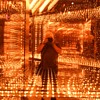Posted 13 years ago
 bushrat
bushrat
(39 items)
While the public often refer to these smaller canoes as "salesman's samples", that term is really a misnomer in the case of factory-made miniature canoe samples. These items were really meant for static store display - i.e., to be hung from walls and ceilings, or sit on counter tops, not for carrying about the countryside. Most were between 3' and 8' long, and not all that many were actually made. In Canada, early canoe factories made very few, perhaps no more than a handful each. In the US, some factories made a few, but others, such as Kennebec, made 60 recorded pieces, while Old Town likely made several hundred. All-in-all, they are fairly rare items.
Above, from left, a 30" wide-board, wide-ribbed model by John S Stephenson, c. 1870. Stephenson was one of the earliest North American builders of board canoes, and worked in Peterborough, ON, as early as the 1850's; second, a 36" wide-board, rib and batten model by the Peterborough Canoe Co., c. 1900 (PCC was a successor owner of Stephenson's patents and technology); third, a 72" wide-board, rib and batten sample by the Rice Lake Canoe Co., Gore's Landing, ON, c. 1890-1900. (Rice Lake Co. was a successor of Daniel Herald, who began in 1862, and was a competitor of Stephenson); fourth, a 32" wood/canvas sailing canoe model resembling the work of William English, c. early 1900's. (Wm. English began making canoes in the Peterborough area in the late 1850's/early 1860's, another competitor of Stephenson, Herald and Thomas Gordon.)
The invention of the board canoe - meant to replace dugouts (through lighter weight) and birch bark canoes (through greater strength) - was eventually succeeded by the wood/canvas canoe. The above samples demonstrate somewhat this technological progression.
















Interesting research history. Thanks for posting
You're very welcome. It's one of my passions, and fun to share. You might also like to view my website: antiquemodelcanoes.com. It has a lot more pieces from all over the World.
Thanks, Knifeguy. Nice 'hawk you posted.
Thanks Bellin
It has taken a long time, 2022, but I have finally gotten around to writing my manuscript on early N. American "display" sample canoes. They really deserve to be described as display pieces because they were never widely handed out to sales personnel. Only about 300 in total were ever made before WWII by all the canoe makers added together. Old Town made the most (about 130), Kennebec the second largest (60). Many others made none, or only a handful. Just one sample by Rushton is known, and one by J R Robertson. Canadian factories likely made less than 2 dozen, altogether. So, they're very rare and, consequently, pretty expensive to buy. Don't get fooled by cheap fakes. Look for my book or articles I have written; it will show you the real thing, with lots of great photos, as well.